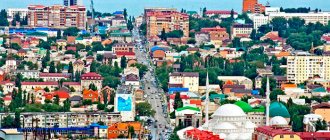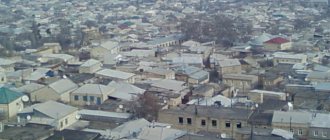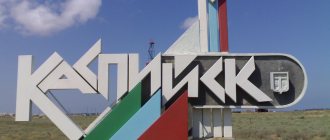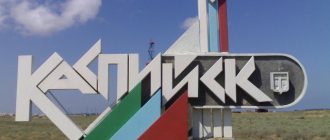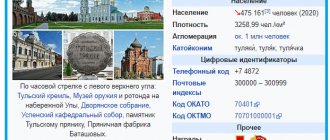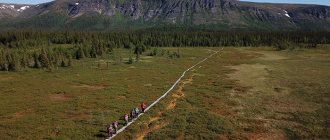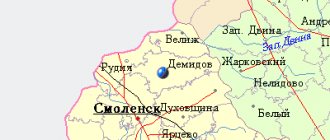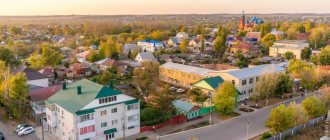Makhachkala is a Russian city located in the southern part of the country. It is also the capital of the Republic of Dagestan. Those who have ever visited this beautiful place as a traveler know that this is a city of contrasts: on the one hand, the majestic mountains of the North Caucasus, on the other, the waters of the Caspian Sea. Perhaps tourists with a wide variety of requirements and preferences will find something here that they will remember forever.
Population of Makhachkala
Who lives in this city? Knowing the temperament of the Dagestanis, we can conclude that Makhachkala is inhabited by people with a strict Caucasian character, but at the same time very kind and hospitable. They are ready to help you at any time if you need it. And when you are hungry or want to relax, they will happily feed you and give you something to drink. Hot corn, locally produced cognac, as well as a variety of Caucasian delicacies - all this can be found in the capital of Dagestan.
Makhachkala ranks first in terms of population and area among all cities located in the North Caucasus. In addition, statistics for 2016 indicate that it is in 27th place out of 1112 largest in Russia. Thus, we can safely say that Makhachkala is one of the few and rapidly growing large cities in the Russian Federation. Most settlements after the collapse of the Soviet Union showed a significant decrease in population figures.
According to the latest data, about 593 thousand people live in Makhachkala.
MAKHACHKALA
Rosfoto / K. Skorobogatko Makhachkala. Panorama of the city.
MAKHACHKALA, a city in Russia, the capital of Dagestan. Population 601.3 thousand people (2019). Located on the Primorskaya Lowland, at the foot of Mount Tarkitau. Seaport on the western coast of the Caspian Sea. Railroad station. The Caucasus federal highway passes through Moscow (Krasnodar – Grozny – Makhachkala – border with Azerbaijan). Uytash International Airport.
Story
In 1844, during the Caucasian War of 1817–64, on the Anji-Arka hill near Tarkov, the capital of the Tarkov Shamkhalate, the Russian fortification of Petrovskoye was founded, named in memory of the Persian campaign of 1722–23, organized and carried out by the emperor. Peter I. The construction of Petrovsky pursued several goals: strengthening control over the road passing through Tarki along the Caspian coast to Derbent (the oldest route connecting the countries of the East with the North Caucasus and Russia); increasing the security of the Tarks themselves; protection of coastal territory suitable for the future creation of a seaport. Since 1857, the port city of Petrovsk (the name Petrovsk-Port gradually became established); obeyed commands. troops and the manager of the civilian unit in the Caspian region. Since 1860, it was a district town in the Dagestan region (along with Derbent it had a civil administration). From the 2nd half. 19th century Industry was actively developing in the city, a brewery, 2 tobacco factories were built, in 1861–70 - an artificial harbor and seaport, in 1900 - a paper spinning factory "Caspian Manufactory", in 1914 - an oil refinery. Fishing has become one of the priority areas for the development of the city. In 1894, traffic was opened on the Beslan-Petrovsk-Port railway line, in 1900 - Petrovsk-Port - Derbent, at the end. 1915 – Shamkhal – Temir-Khan-Shura (connected the city with Mountainous Dagestan) of the Vladikavkaz railway.
During the Civil War of 1917–22, Petrovsk-Port changed hands several times. In the end 1917 – March 1918 and April. – Sep. 1918 one of the centers of Soviet power in Dagestan. In the spring of 1918, he was twice engaged in the detachments of N. Gotsinsky. In Aug. 1918 besieged by a detachment of L.F. Bicherakhov (see Art. Bicherakhov) with the support of ships of the Caspian flotilla, occupied by them on October 3, occupied by units of the Turkish army on November 8, became part of the so-called. Mountain Republic (see Art. Mountain Governments) and renamed Shamil-Kala. On May 8, 1919, it was taken by units of the All-Soviet Socialist Republic and was under their control until the spring of 1920. Occupied by units of the Red Army on March 30, 1920 during the North Caucasus offensive operation. In 1921–94 the capital of the Dagestan Autonomous Soviet Socialist Republic, from 1994 - the Republic of Dagestan. By decree of the All-Russian Central Executive Committee dated July 10, 1922, the city was renamed Makhach-Kala (the spelling “Makhachkala” was fixed) in honor of the famous Dagestan revolutionary Magomed-Ali (Makhach) Dakhadaev (1882–9/22/1918; in May–September 1918, military commissar of the Dagestan region). In 1970, the city was seriously damaged by an earthquake. In 1999, the administration and residents of Makhachkala actively contributed to the expulsion of terrorist groups during their invasion of Dagestan.
Architecture
Photo by P. S. Pavlinov Makhachkala. Hotel "Dagestan". 1938–39. Architect G. Grimm.
In the old coastal part of the city there are: a lighthouse at the foot of the Anji-Arka hill (1860s), the Assumption Cathedral in the neo-Byzantine style (1905–06; chapel of St. Alexander Nevsky - 2004), buildings of the 2nd half. 19 – beginning 20th centuries in the spirit of eclecticism (buildings of the public library - 1899–1900, the former women's gymnasium - 1903, etc.). In the 1920s–1930s. active construction of the city was underway, including according to the general plans of 1931 and 1938 with a rectangular grid of streets; the Main Post Office was built in the style of constructivism (1920s), the Government House in the spirit of neo-romanticism using oriental motifs (1927–28, architect I. V. Zholtovsky; now the agricultural academy), the Dagestan hotel in the spirit neo-Renaissance (1938–39, architect G. Grimm). After the Great Patriotic War, an administrative building was built on Leninsky Prospekt (1956, architect A. M. Alkhazov), the Trud stadium (opened in 1958, completed in 1961), the House of Pioneers (1961, architect A. G. Oruskhanov), University (1964, architect Sh. I. Kerimov, G. M. Sheikhov). According to the general plan of 1961 (architect K.V. Chernokozov), the following were organized: Primorsky Boulevard (1962, architects N.I. Ozernaya, A.G. Oruskhanov; now the City Garden with Rhodope Boulevard) with a monument to the poet Suleiman Stalsky (1949, sculptor Kh. N. Askar-Sarydzha, architect Alkhazov) and a drama theater (1967, architect G. Ya. Movchan and others; now the building houses the Avar and Kumyk musical and drama theaters), the central square with the new Government House (1967, architect Alkhazov) and a monument to V.I. Lenin (1960, sculptor Z.I. Azgur, architect G.A. Zakharov). According to the general plan of 1973, a number of buildings were erected for cultural institutions and others. Among the buildings of the 1990–2000s. – Central Juma Mosque (1997), North Caucasus Islamic University. Many houses are decorated with mosaics and high reliefs. Monuments: G. Tsadase (1956, sculptor Askar-Sarydzha, architect A. M. Alkhazov), S. M. Kirov (1975, sculptor B. A. Tanaev, etc.), Dagestan Bolsheviks shot by the White Guards in 1919 (1980 , sculptor G.N. Geybatov), Defender of the Fatherland (2006, sculptor Sh. Sh. Shakhmardanov); in the park named after Lenin Komsomol - a memorial to the soldiers who died in the Great Patriotic War (1976, sculptor Yu. P. Pomer and others, architect V. A. Bederov, under the direction of A. A. Emirbekov), and a monument to the athlete Ali Aliyev (1998, sculptor Geibatov).
Centers of science and culture
The city operates: Dagestan Scientific Center of the Russian Academy of Sciences (1991), including St. 10 scientific institutions, including the Institute of Physics named after. Kh. I. Amirkhanova, Institute of History, Archeology and Ethnography, Institute of Language, Literature and Art named after. G. Tsadasy, Scientific Association “IVTAN”; Dagestan Scientific Center of the Russian Academy of Medical Sciences (1993); Caspian Zonal Research Institute of Veterinary Medicine; scientific and production association "Dagagrovinprom" and others. Dagestan state universities: university (founded in 1931 as a pedagogical institute; since 1957 modern name and status), pedagogical university (opened in 1917; restored in 1931, since 1943 women's teacher's institute, since 1963 Pedagogical Institute, since 1994 modern name and status), Agricultural Academy (founded in 1932 as a fruit-growing institute), Medical Academy (founded in 1932 as a medical institute; building in the neo-Renaissance style, 1935, architect G. S. Tegkaev), Technical University (founded in 1972 as a polytechnic institute, modern name since 1995), Dagestan State University of National Economy (1991); branches of state universities in Moscow, St. Petersburg, Rostov, etc. There are republican libraries: the national one. R. Gamzatov (1900; building - 1974–1997), for the blind (1962), children's (1969), youth named after. A. S. Pushkin (1997), as well as the city library (1930) with 15 branches. Museums: Dagestan State United Historical and Architectural Museum named after. A. A. Taho-Godi (founded in 1923 as a local history museum, since 1977 its modern name), has branches, including the Museum of Military Glory, the Museum of the History of Makhachkala; Republican Museum of Fine Arts named after. P. S. Gamzatova (1958); Museum of the History of Theaters of Dagestan (founded in 1984, opened in 1990).
Theaters: Republican Russian Drama named after. M. Gorky (1925; building - 1984, architect Kh. V. Chkheidze), Kumyk Musical and Dramatic Theater (1930, since 1955 named after A.P. Salavatov), Laksky Musical Drama Theater (founded in 1935 in the village of Kumukh, since 1952 named after E. Kapiev), Avar Musical and Drama Theater (founded in 1935 in the village of Khunzakh, since 1951 named after G. Tsadasa), puppets (1941), Dagestan State Opera and Ballet Theater (1999). State Philharmonic named after. T. Muradova (founded in 1945; its composition includes the Chamber Orchestra, 1988). State Symphony Orchestra, State Choir, State Orchestra of Folk Instruments of the Republic of Dagestan (all 2004). Folk choir of Russian song “Volna” (1957); Song and dance ensemble of Dagestan, dance ensembles: “Lezginka”, peoples of the Caucasus “Youth of Dagestan”. The traditions of the ancient art of tightrope walkers are developed by the groups “Dagestan Rope Walkers” and “Tsovkra”. International Festival of Folklore and Traditional Culture “Highlanders” (since 2004).
Sport
Football club "Anji" (founded in 1991), participant in a number of Russian championships in the Top Division and Premier League (2000–02, 2010–14, 2015–19; bronze medalist in 2013), UEFA Cup (seasons 2000/01, 2012/13 and 2013/14), Russian Cup finalist (2001 and 2013); until 2003 he performed at the Dynamo stadium (opened in 1927, built in 1949, architect A. S. Sahakyan; reconstructed in 1968 and 2000, over 15 thousand seats), after - at the Anzhi Arena stadium (formerly – “Khazar”; located in Kaspiysk; opened in 2003; capacity 26,400 spectators). Other football clubs in the city: Dynamo-Dagestan-Anzhi (founded in 1927 as Dynamo; winner of the RSFSR Cup 1967), Legion Dynamo (2015), Makhachkala (2019).
Farm
Makhachkala is the leading industrial center of Dagestan. The most developed are mechanical engineering, light and food industries; Oil refining and production of building materials are important. The largest enterprises: plant named after. Gadzhiev (ship and oil and gas equipment, pumps, etc.), "Aviaagregat" (airfield equipment and ground support equipment for aircraft, components and components for aircraft, passenger cars), "Eltav" (microcircuits, transistors, etc.), Research Institute " Sapphire" (automatic direction finders, systems for testing on-board navigation equipment), separator plant (products for food industry enterprises), "Russian Radio Electronics Research and Production Complex" (navigation and communication systems, antennas). There are also factories in operation: oil refineries "Caspian-1" and "Dagnotech", paint and varnish products (the only one in Dagestan). Production of furniture (furniture factories "Caspian", "Tronmebel", "Agama", etc.), cotton fabrics ("Caspian Manufactory"), knitted fabric, hosiery ("Dagtextile"); leather dressing, processing of fur raw materials and wool, etc. Among the leading food industry enterprises are the meat processing plant, Makhachkala Hormol (fish products), Makhachkala Bread Product. The production of alcoholic beverages has been developed: the Port-Petrovsk brewery, Kaspiyvinprom, a champagne and wine plant (production of vodka) and Dagestan-Ethanol (production of alcohol). Bottling of mineral waters and production of soft drinks (Start, ARS). House-building plants "Dagstroyindustriya" and Makhachkala; factories: reinforced concrete products and brick (“Silicate”), production of fiberglass.
One of the significant sectors of the city economy is transport services. Makhachkala is the main seaport of Dagestan, dating back to 1870, the only practically ice-free Russian port on the Caspian Sea; includes a dry cargo harbor with a capacity of 3 million tons of cargo turnover per year, berths for general, bulk cargo and containers with a capacity of up to 1.2 million tons per year, a railway and road ferry terminal with a capacity of 1.3 million tons and a grain terminal with a capacity of 0.5 million .tons per year. Main cargoes: mineral and construction raw materials, oil and petroleum products, grain.
Makhachkala in numbers
The capital of Dagestan can be considered a completely international city. Nevertheless, the national composition of the population of Makhachkala differs slightly from the national data. The largest part are Avars. About 27% of them live in Makhachkala. However, this figure is slightly lower than the national figure, which is 29.4% (these data were obtained and recorded during the All-Russian Population Census). In second position are the Kumyks - about 19.3% of them here (for comparison: 14.9% of this people live in the entire territory of Dagestan). Next come the Dargins - 15.4% of the total population of the city of Makhachkala and 17% in Dagestan. There are slightly fewer Lezgins here - about 12.8%, followed by Laks - 12.4%. As for Russian nationality, its representatives in the capital of Dagestan are approximately 5.4% and 3.6% throughout the republic. There are also quite a lot of Tabasarans (2% and 4.1%).
Ecological situation in the regions of Makhachkala
There are no large heavy industrial enterprises in the city. This creates a favorable environmental situation. The exception will be houses and courtyards along central roads. Due to the large traffic flow there is an abundance of exhaust gases. The most polluted place in the city is the waters of the Caspian Sea. “No swimming” signs regularly appear on city beaches. But that doesn't stop the locals. The city has a favorable geographical location. On one side there are mountains, on the other there is the Caspian Sea. Therefore, there is fresh air and sea wind in Makhachkala all year round.
View of the Old Town and Petrovsky Lighthouse
Residents of the urban district
Now let's look at how the population of the urban district is distributed, which includes residents of nearby areas and villages. According to reliable data, 82.1% of them live directly in Makhachkala itself. Most of the townspeople live in the Sovetsky district of the city. Leninsky and Kirovsky districts are slightly smaller in population. In general, the population is distributed more or less evenly. Every 5-6 citizens of the Makhachkala district live in villages, and the largest number of them live in the villages of Leninkent and Tarki.
Industrial Leninsky
It is located in the south of the city and is considered its production center. There are 24 industrial enterprises in Leninsky. Their area occupies half of the district. The second half is residential.
Population: 207.5 thousand people.
The area has well-developed social and cultural spheres. There are kindergartens, schools, hospitals, hotels. For tourism the following will be of interest:
- Two city beaches along the Caspian highway.
- Drama Theater.
- Hippodrome.
- Several monuments, including the “Russian Teacher”, opened here in 2006.
- Rhodope Boulevard is 2 kilometers long. Known for its green alleys and historical monuments.
- Suleyman Stalsky Boulevard with a copy of the Petrovsky Lighthouse.
- Several museums.
- Mosques.
- Lake Ak-Gel.
THIS IS INTERESTING. According to legend, on the site of the Petrovsky Lighthouse, Peter the Great once laid the first stone of the future city. Then it was the Port-Petrovsk fortress, which later became Makhachkala.
Monument to the “Russian Teacher” in the center of Makhachkala
Several microdistricts can be distinguished in the residential area of Leninsky.
Reduktorny village
There are two types of buildings in Reduktornoye - five-story Soviet “panels” and modern multi-story new buildings. The area is being actively developed with new residential complexes with their own infrastructure. Prices per square meter start at 55 thousand rubles. The advantage of the area is its location. The Caspian Sea stretches on one side, Lake Ak-Gel on the other. There is a large park next to the lake. The village has the necessary social, sports, educational and cultural facilities.
Development of the village of Reduktornoye
New Khushet
The young microdistrict stands on the border with the neighboring city of Caspian Sea. Initially, the village had exclusively a private sector, but today there is active construction of new housing stock. Mostly cottage villages are being built. And because of its proximity to the sea, developers of hotel complexes became interested in the place. The disadvantage of Khushet is the undeveloped infrastructure and lack of green areas. A square meter of real estate will cost around 40 thousand rubles.
Typical building of New Khushet
New Kyakhulai
A quiet village in the north of the region with well-developed infrastructure. The buildings are mostly private, with 2-3 storey cottages predominating. People come here for the silence and views - the village looks like an ancient village. There are practically no young people here. Kähulay borders with modern residential areas. The average price of a cottage of 150 square meters is from 10 to 12 million rubles.
Border of Kyakhulai village and modern residential areas
Center
The two busiest and most expensive streets in the city are Gamzatov Avenue and Shamil Avenue. They pass through the Sovetsky and Leninsky districts. The streets are densely built. There is no room for new buildings here, so secondary housing is highly valued. The average price per square meter of real estate is 95 thousand rubles. The center has a developed infrastructure and the main city attractions. The downside is the most difficult traffic in Makhachkala, noise and exhaust fumes. THIS IS INTERESTING. On the border of the Leninsky and Sovetsky districts there is the Fifth Village microdistrict. It is called the most crime-prone place in the city.
Imam Shamil Avenue in Makhachkala
Visitors to Makhachkala
In addition to the local population, visitors regularly arrive in Makhachkala. The capital of Dagestan is visited annually by a fairly large number of tourists. What attracts visitors to this place? Those who come here in search of work are attracted by the high salary level and the feeling of a large city. Travelers are attracted by the entertainment infrastructure (concert venues, gyms, etc.). Tourists are also impressed by the abundance of shops. The population of Makhachkala is quite diverse, but all these people are united by the Caucasian tradition - hospitality. Picturesque nature and national flavor will not leave tourists indifferent. After the impressions received and an unforgettable vacation, everyone will want to visit here again.
Three districts of the city on the Caspian Sea
The capital of Dagestan is rapidly gaining momentum as a tourist Mecca of the North Caucasus. Situated on 468 square kilometers, Makhachkala is a major economic, scientific and cultural center of the Russian south and the largest city in the region. The modern city on the Caspian Sea is geographically divided into three districts:
- Leninist;
- Kirovsky;
- Soviet.
Their main feature and difference from the areas of other Caucasian cities is the constant population growth and rapid economic and social development.
Ethnic composition
Considering the ethnic groups that inhabit the territory of the Republic of Dagestan, it is worth providing the following data in the list:
- The number of Russians in the republic is small and amounts to approximately 3.5%.
- The most numerous is the Nakh-Dagestan group, which includes Tabasarans, Tsakhurs, Lezgins, Avars, Archins and others. In total, about 74% of the republic's population.
- Peoples of the Turkic group also live here - the Nogais, Kumyks and Azerbaijanis. Their total number does not exceed 20%.
- The least numerous are the peoples of the Iranian group, including the peoples of Mountain Jews, Ossetians and Persians, the total number of which does not exceed 1% of the population of the Republic of Dagestan.
Thus, it can be argued that the predominant nationalities of Dagestan in terms of numbers are the indigenous peoples of the republic. And they are followed by the peoples and nations of the territories adjacent to Dagestan.
Marriages and divorces
If we briefly describe the statistics on divorces, the following data is given for the indicated population:
- In 2022, the number of marriages in the Republic of Dagestan amounted to 14,748 units, which was 108% as a percentage of the previous period.
- In 2022, during the month of July, 6,079 marriages were concluded, which is slightly lower than in the previous reporting period. But the decrease in the number of newly registered families is most likely due to isolation measures taken during the spread of coronavirus infection.
The final statistics for 2022 can clearly show how the figures for the 2 reporting periods compare.
Gender and age
Considering the distribution of residents of Dagestan by gender, it is worth noting that per 1000 men there have been the following number of women over the past 15 years:
- 2005 – 1070 female residents.
- 2012 – 1080.
- 2015 – 1077.
- 2017 – 1074.
As can be seen from the data presented, this number has remained virtually unchanged throughout the 2000s. But as for age, it is interesting not only what the number of residents is in the republic, but also how it is distributed among different age groups for 2016:
- From 0 to 14 years – about 25%.
- From 15 to 29 years old – 26.1%.
- From 30 to 44 years old – 21.2%.
- From 44 to 54 years old – 18.9%.
- From 55 to 69 years old – 14.7%.
- Over 70 years old – slightly more than 4%.
Information about the republic
When considering the Republic of Dagestan, it is worth considering not only what population lives here, but also history, geographical features and other interesting facts and information about the region:
- Thus, the total area of Dagestan is 50,270 sq. km, which puts the region in 52nd place in the Russian Federation.
- The population density is 61.88 people per sq. km.
- Most of the population lives in villages – 54.69%. The rest are city residents.
- The gross product per capita is 203.3 thousand rubles, which puts the region in 32nd place in the Russian Federation.
- Ethnic diversity provides unique cultural riches. There are numerous museums, state theaters and philharmonic societies here.
- From the point of view of historical events, the territory of Dagestan is divided into regions. The first settlements existed here 2 million years ago.
- The rich historical period of the republic begins with the Paleolithic period and passes through the Middle Ages, rich in various events. In 1801, the population of the region, represented by the utsmiy, the ruler and the khan, turned to the Russian Emperor Alexander I for citizenship. Since 1802, a province was formed on this territory, which was called Caucasian. In May 1917, the 1st Mountain Congress was formed here after the autocracy was overthrown. The territory became part of the Union of Soviet Republics in mid-spring 1918.
- Oil and natural gas production, agriculture, mechanical engineering, chemical and light industry are developed in the territory.
Walking route around Makhachkala: Getting to know the city center
As a rule, the first visit of tourists to Dagestan begins in Makhachkala. It doesn’t matter whether you arrived here by plane or by train, take the time to walk around the center of the capital. The city has many interesting architectural monuments, beautiful parks, and walking avenues.
Pedestrian street Buynaksky
© Julia Alisova
It’s convenient to start your acquaintance from the Makhachkala railway station building.
Near it there are many iconic attractions: Kumyk Musical and Drama Theatre, Rhodope Boulevard, city beach, Buinaksky promenade. They're worth a little time and even a snack if you're hungry.
From physical hunger to spiritual. Here, in the historical center of Makhachkala, there is a popular museum.
National Museum of the Republic of Dagestan named after. Tahoe-Godi is 19 halls with priceless artifacts from different eras, from the Paleolithic to the period of the Caucasian Wars and the beginning of the 20th century. This is one of the largest collections in the entire North Caucasus.
The building that houses the museum is no less remarkable; it is the restored house of Prince Baryatinsky - the so-called “House with Atlantes”.
Next to the historical exhibition there is an ethnographic exhibition, the Dagestan Aul . Here you can see clothes, household items, carpets, dishes and jewelry of different nationalities of Dagestan.
From here it is easy to walk to the main attraction of the Dagestan capital. The magnificent Central Juma Mosque is the architectural and sacred “calling card” of Makhachkala.
Central Mosque of Makhachkala
© Julia Alisova
The Juma Mosque in Makhachkala is the largest mosque in our country; it can accommodate 17,000 visitors at a time. Be sure to take a look inside, its interiors are amazing. Endless vaults run up to the ceiling, which is painted with bright frescoes and flowers.
Check out the stunning wrought iron chandeliers, handcrafted by Syrian craftsmen, and the beautiful carpets. Representatives of any religion are allowed to enter the mosque; girls enter the temple from the side, men from the central entrance. The mosque has a strict dress code: bare hair, arms and knees are not allowed.
The mosque is located very conveniently, it is very close to both Lenin Square and the central market of Makhachkala. If you're hungry, come here.
There is also a good promenade located on Rasul Gamzatov Avenue , the central and historical street of Makhachkala. It has been known since the end of the 19th century as one of the main streets of the capital.
Madrasah building of the 19th century on Gamzatov Avenue
© Julia Alisova
There is a kaleidoscope of architectural masterpieces here, both ancient and modern. Pay attention to the National Library, the building of the Russian Drama Theater, the puppet theater, the ancient premises of the madrasah of the 19th century, the House of Poetry, and the high-rise building of the Leningrad Hotel.
Part of the avenue is designed as a pedestrian area, with modern recreation areas waiting for you. As well as excellent cafes, restaurants and pastry shops.
It is impossible to remain hungry on Gamzatov Avenue; there are both local street food counters and cafes of the Shokoladnitsa and Black Star Burger chains.
